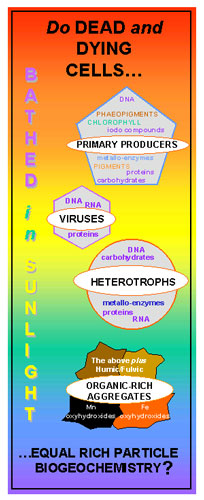There is reason to believe that, like solutes, particles and sorbates in them are also very photoreactive. However, very little is known about their photochemistry, due mainly to methodological difficulties, such as quantifying photo-chemically generated oxidants and reductants within natural particles and distinguishing processes in living, enzymatically active cells from those occurring in "dead" particles. Recent work suggests that much of the chlorophyll in the upper ocean has been modified by photo-oxidation within cells (Cuny et al., 2002).
Methodology: This-wide-open area contains many thesis problems with emphases ranging from laboratory studies of model systems (starved bacteria or plankton cultures, humic-coated oxides) under controlled conditions to fieldwork, such as extending studies cited below on manganese oxides or chlorophyll photo-oxidation. A critical advantage for natural population work is the availability of flow cytometric sorting methods that permit the isolation of specific particle subclasses.
Wider Implications: The behaviors of living and nonliving
particles in the upper oceans, lakes and rivers are strongly linked to
many other important aquatic environmental processes, yet both living
and non-living particle dynamics are huge wide-open areas, especially
where process identification and quantification are concerned.
Suitable For: Majors or strong minors in chemistry or biochemistry with independent research experience. Work involves many facets of chemistry: general, orgo-, p-, bio-, environmental- and analytical. A generalist attitude plus the detail-orientation needed to develop new methods is a plus.
Training: Involves concepts, methods, assessing/advancing state-of-the-art in:
- Aquatic organic chemistry and photochemistry; developing new methods
- Particle sampling, characterization, and chemical analysis
- Gaining experience in a wide array of laboratory, seagoing, and presentation
skills.
Additional Relevant Links:
References:
- Cuny, P; Marty, J-C; Chiaverini, J; Vescovali, I; Raphel, D;Rontani, J-F. (2002). One-year seasonal survey of the chlorophyll photodegradation process in the northwestern Mediterranean Sea. Deep-Sea Res. (II), 49, 1987-2005.
- SooHoo, J.B. and Kiefer, D.A. (1982a). Vertical distribution of phaeopigments - 1. A simple grazing and photooxidative scheme for small particles. Deep-Sea Res. 29, 1539-1551.
- Sunda, WG; Huntsman, SA (1994). Photoreduction of manganese oxides in seawater. Mar. Chem. 46, 133-152.
- Scharzenbach, R.P., P.M. Gschwend, and D.M. Imboden. (2003) Environmental
Organic Chemistry. 2nd Edition. Wiley-Interscience, New York, NY.
1313 pp.
